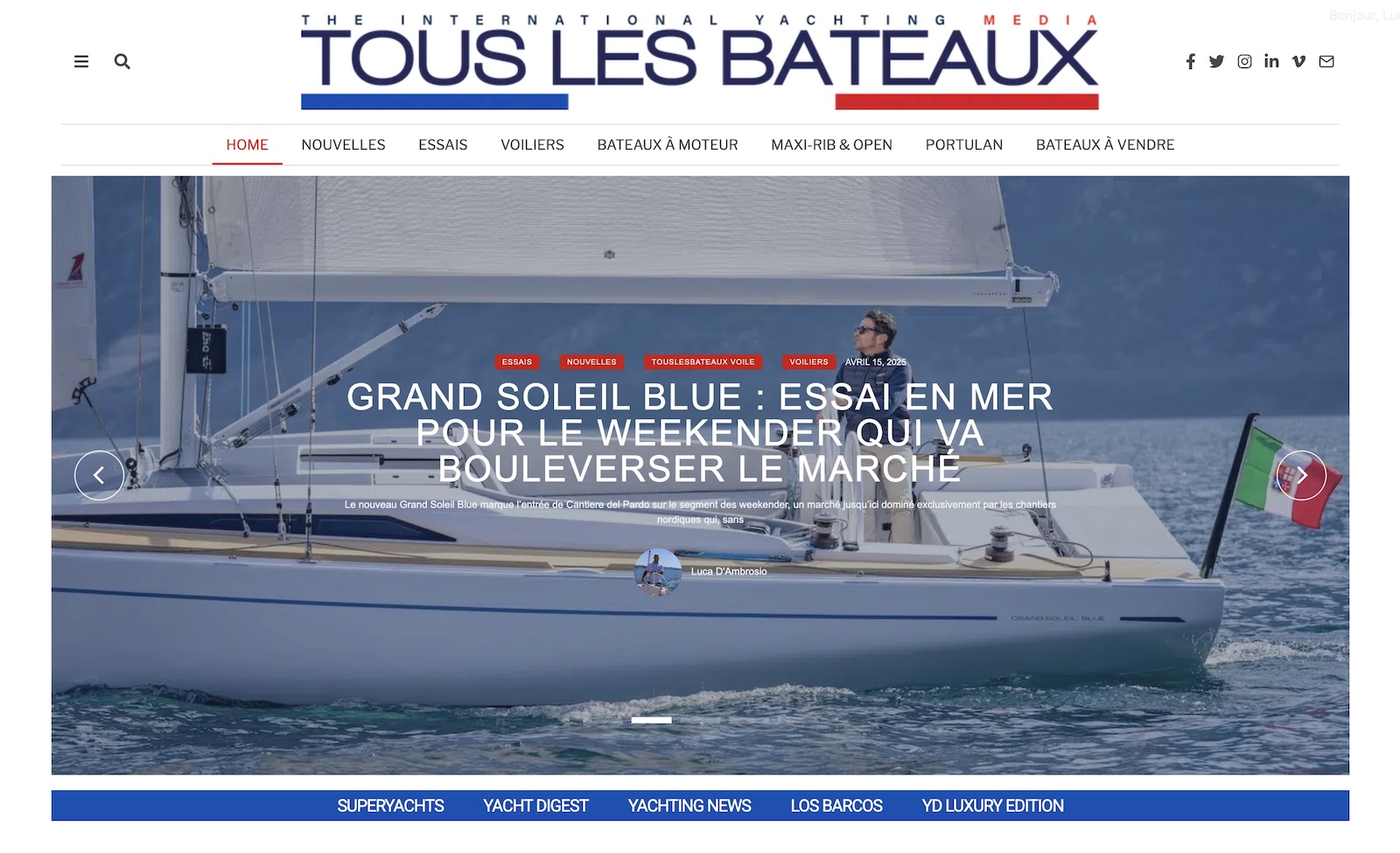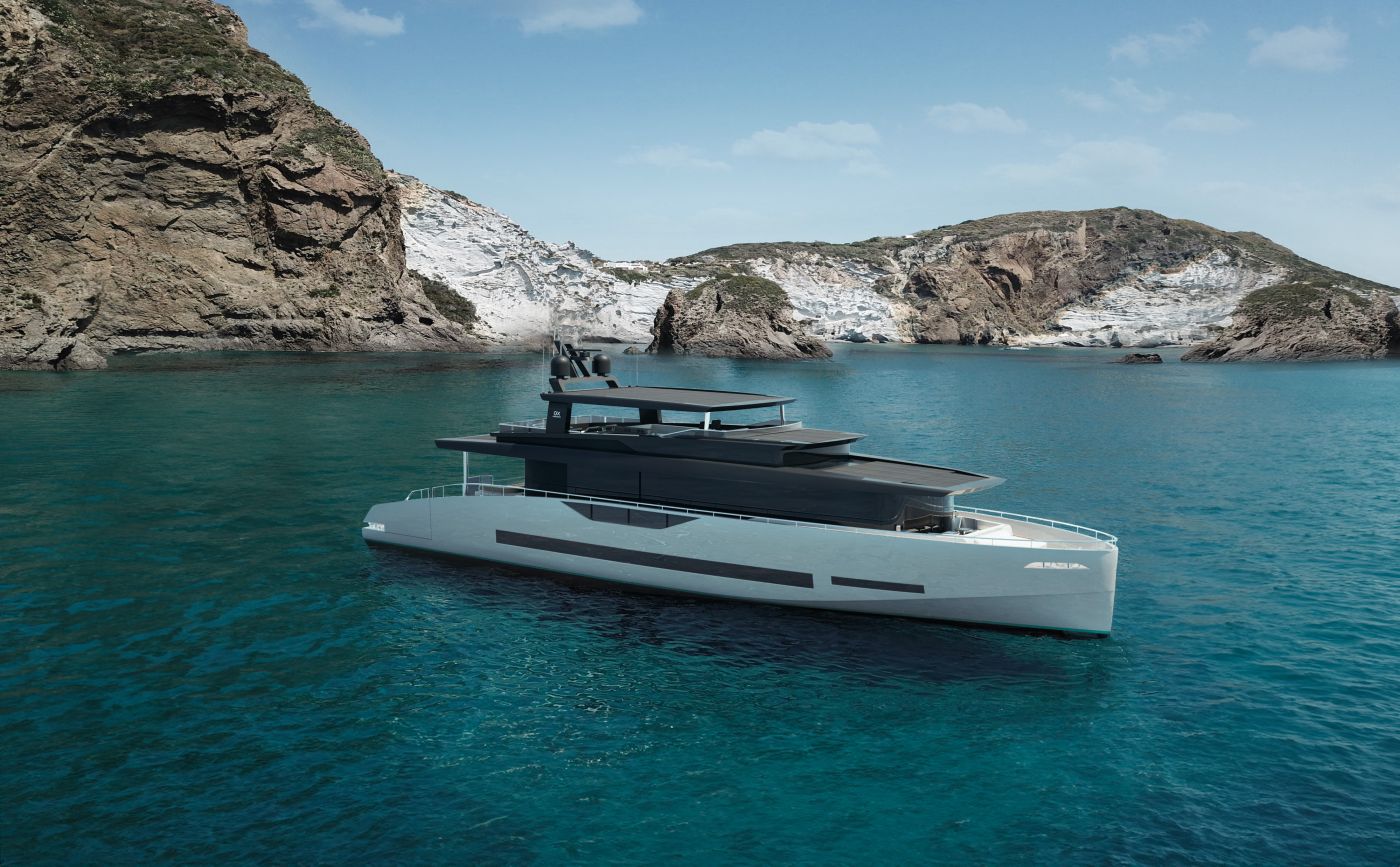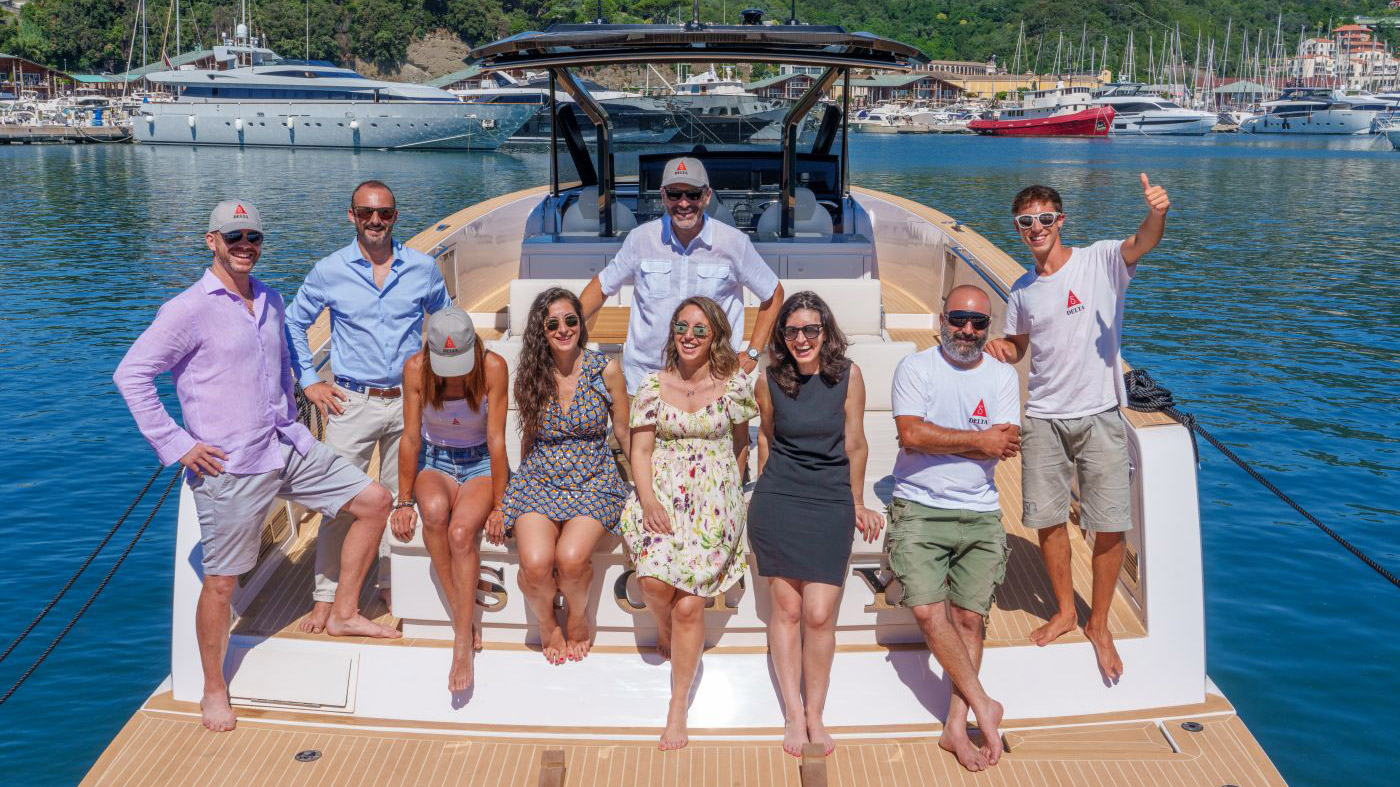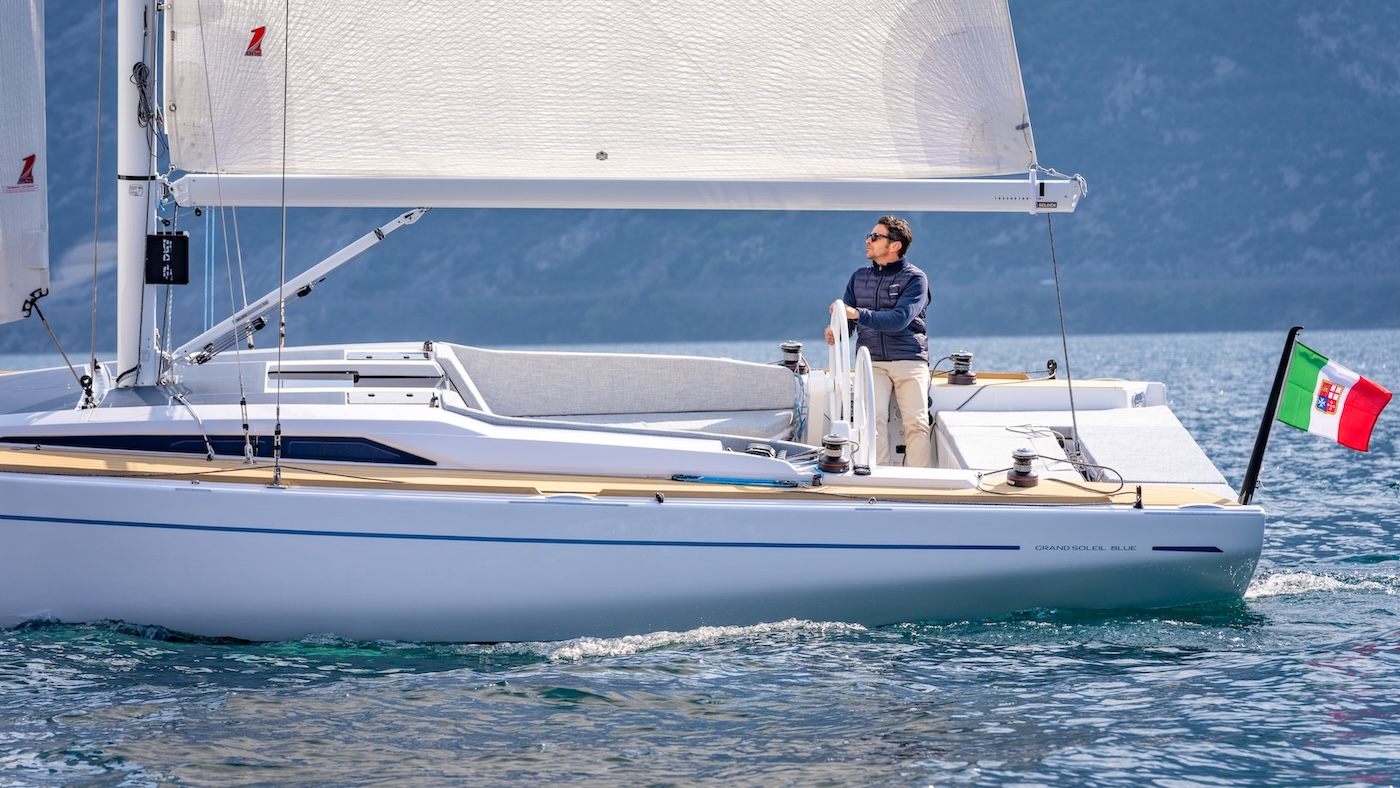We approach to Oscar 3, the new Mylius 65 FD, sailing fast on a rib which brings us aboard on a flat sea just opposite the marina of Cala de Medici .
The hull seems to be slightly leaned against water, stationary and inanimate in the total absence of air. Once we’ve arrived alongside, the boat looks much more imposing than it really is and actually appears once one is on the deck. The lull makes everyone gloomy. Everyone desires to make the first sea trial of this boat and our expectations are really high. Some hours later, something finally changes: at about 01:00 pm, the thermal, cooled by a light west wind, starts to blow. It is very light but sufficient to bring us the joy to run faster than the wind.
The boat
The Mylius 65 is not an unprecedented project. But the innovations this model houses are so important that they make it a completely new boat. With a length of 20 metres and a width of more than 5, Oscar 3 is entirely made of carbon. The result is a light displacement (little more than 20 tons) which ranks the boat as one among the lightest vessels in her class.
In this choice -which is reflected in many other features, from the deck equipment to the interiors in smoked eucalyptus and open pore oak – lurks a precise owner’s will got by the yard, namely that of producing a fast cruiser-racer equipped for cruises but substantially ready for serious racing.
Like all the other Mylius boats, the project is by the architect Alberto Simeone who imposed a deep evolution in comparison with the bottoms of the previous 60′ and 65′ models. First of all, the hull is wider, with a very recessed maximum beam. The aim is to have a greater holding and course stability, in addition to better performances at high speed. Waterline length, too, is greater and, thanks to the lower weight, the displacement/sail area ration is improved. All these innovations translate, of course, into better performances.
As regards the construction, the boat uses a sandwich of carbon fibres with an expanded PVC differentiated-density core (lamination is solid only in some areas subject to a greater load). The rudder axis, too, uses a solid carbon laminated stock while a carbon sandwich has been used for the rudder.
Deck and equipment
Except for the differences on the arrangement level, the flush deck brings the typical Mylius trademark. Extremely clean, all rigging is within reach and the result is a beautiful surface covered in teak which gives passengers a total freedom of movement aboard.
In the cockpit, sizes inspire an inebriating sense of freedom. Anything seems possible also thanks to the rigging arrangement which requires a single crew member in the case of a quiet cruise.
The mainsheet winch is mounted on a central column, which also receives the two sheets of the German circuit. Forwards, a long and very efficient traveller, completely recessed, marks the ideal separation between the rigging area in the cockpit and the guest one.
Other four winches, always electric like the central one, are arranged on the aft end of the benches. The two outermost ones serve the fore sail sheets, equipped with no rails, and replaced with a flying barber system in case of a racing arrangement. While on cruise, on the contrary, the self-tacking jib runs on a track situated before the mast.
When gennaker, Code or other asymmetric fore sails are used, the tack is on a dolphin striker, which also works as anchor arm.

Interiors
When we talk about interiors in boats of this class, nothing can be considered as standard. The level of customization is very high in terms of spaces, materials and equipment. However, we need to consider two important aspects when we talk about the interiors of Oscar 3. First of all, we’re talking about a shipyard which has impressed a very strong personality to its boats, able to permeate and characterize every customization. On the other hand, the owner of Oscar 3, Aldo Parisotto, a long-experienced interior designer, has been breathing Mylius air for a ling time since he was also the owner of a Mylius 50′. The resulting contamination of tastes and experiences between the owner and the shipyard has led to an important experimentation and innovation in the layout, details and furnishing materials of the boat, without compromising the traditional Mylius style.
The dinette is a large open space, very bright thanks to the windows running along the deckhouse. Below deck, sizes almost give a sense of loss, especially in case of list. But this sense of dispersion disappears in few seconds thanks to a smart arrangement of handrails which ensure to move safe on the whole boat.
Forwards, the owner’s area is separated from the dinette by a carbon sliding door, beyond which a large balanced room opens, designed around its owner’s tastes and needs. A passage covered with leather leads to the cabin, equipped with a bathroom and a separated shower box. A large closet provides with huge stowage volumes.

Sea trial
After a pair of hours when nothing seems to happen, the sea starts to show some spots of intense blue on the West. Very hesitantly, a light thermal starts to blow. With a full mainsail and Code 0, Oscar 3 starts to amaze. With a 3.5-knot-wind and a real 95-degree-angle, the real speed of the boat is 4.7 knots. The apparent angle is 38 degrees: a huge difference! Oscar 3 has started to do her work by creating apparent wind and producing a speed always faster than the wind’s one.
A small increase in the thermal’s speed is sufficient to let our speed exceed 5 knots. The Code 0 remains aloft for a long time and when the air reaches a real intensity of 10-12 knots the boat flies at over 10 knots (real speed) with an apparent angle of 42 degrees.
The deck is always dry, even when the boat lists and faces a small wave coming from far away. We close the Code 0 and hoist the self-tacking jib just in time to see a light reduction in the wind intensity. But even in these conditions, neither performances nor ratios change and the speed of the boat is always faster than the wind’s one: with a 32-degree-apparent angle and a 7-knot real wind, we touch 8.3 knots.
Sea conditions are optimal and we can’t say anything about the passage on the wave. The rudder ensures an excellent sensitivity in addition to precise immediate corrections. Tight turns, even with very little air, allow us to register a 22-degree close hauled angle with the self-tacking jib while sacrificing a little speed.
The air completely goes down and we come back to the port under power.
Pushed by a Yanmar 160 HP engine, our cruising speed almost reaches 10 knots. Below deck, lights turn on and the warmth released by interiors is not just a matter of temperature.
https://www.facebook.com/tuttobarche/videos/1409006702451686/
Technical Details
Length Overall 20.20 m
Beam 5.25 m
Draft 3.95 m
Displacement 20.500 kg
Ballast 9.300 kg
Cabins 3+1
Bathrooms 3+1
Engine Yanmar 160 hp
Fuel Tank 900 l
Water Tank 845 lt
Sea trial conditions
The sea trial was made with a wind ranging from 4 up to 10 knots, flat sea, 8 passengers and tanks filled to 50%.






























